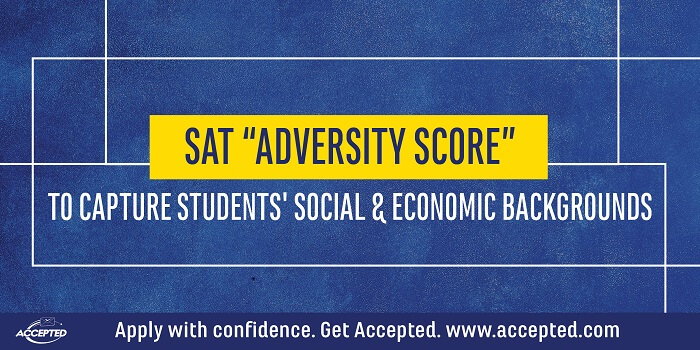SAT “Adversity Score” to Capture Students Social and Economic Background

The Wall Street Journal reports that The College Board (the New York-based nonprofit that supervises the SAT) intends to give every student that takes the SAT an adversity score in an attempt to capture their social and economic background.
How it works
This figure is calculated using 15 indicators including the crime rate and poverty levels from the student’s high school and community. Students will not be apprised of their score, but college admissions staff will see the numbers when they evaluate their applications.
The College Board conducted a beta test last year, during which 50 schools used the score. The number of schools will go up to 150 this year, and will go into general use next year.
The adversity score is score on a scale of 1-100, with 50 being average. A score above 50 indicates hardship, while a score below 50 indicated privilege. It will be found on the Environmental Context Dashboard, which includes indicators or relative poverty, wealth and opportunity in addition to the student’s SAT score in comparison to their classmates’ scores. This score is named “Overall Disadvantage Level.”
The College Board started working on the score in 2015, due to colleges’ requests for more objective information on the background of those applying. There was concern that the Supreme Court may not allow race-based affirmative action. The adversity score does not take race into account.
Why do college admissions boards care about the “adversity score”?
A noisy debate rages over race and class in college admissions. Many colleges, including Ivy League institutions, are trying to increase the diversity of their student bodies. That debate has moved to the courts where pending lawsuits against such schools as Harvard, University of North Carolina at Chapel Hill, and the University of California system charge unfair admissions procedures.
Concern about income disparity influencing test results has long worried admissions offices. In 2018, white students’ scores were an average of 177 points higher than black students’ and 133 points higher than those of Hispanic students. Asian students scored the highest of all – 100 points higher that white students. Those students whose parents were wealthy and college-educated scored higher than their peers from less educated and less affluent families.
According to David Coleman, chief executive of the College Board, “There are a number of amazing students who may have scored less (on the SAT) but have accomplished more. We can’t sit on our hands and ignore the disparities of wealth reflected in the SAT.”
Other SAT weaknesses
The SAT itself is under scrutiny. It tests both math and verbal skills, and is still taken with a Number 2 pencil. A large college admissions cheating plot was recently revealed, which included cheating on both the SAT and ACT for years. There have been security breaks in the SAT and ACT in both Asia and the Middle East.
The adversity score gives the SAT an advantage over the ACT, which does not currently offer this type of information. However, it is expected that ACT will announce a comparable tool later this year.
Diversity, diversity, diversity
Much of the information reflected in the adversity score can be taken from other parts of a student’s application. However, according to Jeremiah Quinlan, the dean of undergraduate admissions at Yale, having the score makes comparisons more reliable. This has led to Yale having approximately 20% of its recently admitted students being low-income and first-generation-to-attend-college.
High schools are feeling the new push for diversity. According to James Conroy, who advises students at an affluent, mostly-white high school, about colleges, diversity is already a priority for elite colleges. “My emails are inundated with admissions officers who want to talk to our diversity kids. Do I feel minority students have been discriminated against? Yes, I do. But I see the reversal of it happening right now.”
Colleges are expecting to hear from well-to-do parents and guidance counselors of the schools these students attend. As more places are taken by diversity students, there will be fewer places for the privileged students. This story is far from over.
[xyz-ihs snippet=”College—SR—Guide-to-Preparing-for-College”]
[xyz-ihs snippet=”Accepted-sig-code—College”]
Related Resources:
• Different Dimensions of Diversity, a podcast episode
• Dimensions of Diversity Checklist
• Top Tips to Improve Your SAT Score

